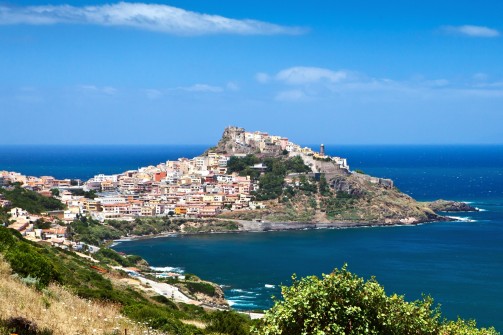Castelsardo is a town in the province of Sassari, which has about 6,000 inhabitants with a density of 136.23 inh./km2. It includes the hamlets of Lu Bagnu, Multeddu, San Giovanni, and Terra Bianca. It has an altitude of 114 m above sea level and an area of 43.34 km2.
The current economy is based mainly on tourism, construction, and fishing. As far as commerce is concerned, the town is well stocked with stores in the various sectors, including local handicrafts.
School services include: a comprehensive institute with kindergarten, “Maestro di Castelsardo” elementary school, “Eleonora d’Arborea” middle school; there is a scientific and language high school and a kindergarten.
The town overlooks the center of the Gulf of Asinara, in the historical region of Anglona in northern Sardinia, in a succession of trachytic rocky coasts with small inlets, with the exception of the beach of Lu Bagnu. Thanks to this position, the locality, in addition to being exposed to the winds, enjoys a unique panorama sweeping over all the coasts of the gulf, including those of Corsica.
Founded in the late 1200s by the Ligurian Doria family with the name Castel Genovese, it was called Castel Aragonese in 1448 by the Spanish. It was finally renamed Castelsardo in 1769, by the Savoy rulers. Crossing the thick walls one is immediately immersed in a timeless atmosphere. On the clearest days the gaze sweeps from Corsica to Asinara, or rests on the women who, on the doorstep, devote themselves to weaving the gardens, chatting in their musical dialect, which brings together Genoese, Aragonese and Corsican linguistic influences.
The mixture of cultures has produced, in the end, a harmonious synthesis that constitutes the true peculiarity of this village, its soul. Not only in the language, but also in the gastronomy, traditions and original artistic craftsmanship can be found the fruit of these Mediterranean cultural intersections.
Perched on a large promontory overlooking the sea, the promontory affords postcard views, particularly from the castle, which now houses the Museum of Mediterranean Interweaving (MIM), Sardinia’s most visited museum site and venue for conferences and cultural events.
Among the most important monuments are the town hall with its loggia, the old convent, now home to the MOG Museum of Genoese Origins, and also the Eleonora d’Arborea palace, the church of Santa Maria and the Cathedral of St. Anthony Abbot, with its bell tower with a dome covered in colored majolica. The cathedral, consecrated in 1503, preserves inside and in the crypts the masterpieces of one of the greatest and most mysterious pre-Renaissance painters, called the “Master of Castelsardo.” One admires, in particular, a retable, pre-1942, composed of four polyptych elements painted by combining tempera and oil on board with a gold background. Also of interest are the urban parks of lu Grannadu and Manganella, located below and above the city walls.
Castelsardo in recent years has become one of Sardinia’s most dynamic tourist centers.


